Salad Greens Basics
Salad greens are an excellent source of vitamin K, which helps stop bleeding.
Shop and Save
- Look for leaves that are fresh and show no signs of wilting or spoiling.
- Buy an amount that you can use within about a week. Bags or containers usually have a “BEST if used by” date.
- Whole heads of lettuce might cost less than containers of ready-to-eat greens and salad kits.
- Containers of mixed greens can provide a variety of different greens in smaller amounts.
- Check a farmers market or farm stand for a variety of local fresh greens in season
Store Well Waste Less
- Greens are best when refrigerated with a little moisture and airflow. Cover greens with a damp paper towel in an open container or make holes in a plastic bag (20 holes in a medium bag). Some greens are sold in plastic boxes with holes. Use greens within 7 to 10 days for best quality.
- Some greens are labeled “washed” or “ready-to-eat”. If greens are not pre-washed, separate leaves and swish in a container of cold water. Lift out of the water and repeat in clean water until no grit collects on the bottom of the container. Drain until just damp or gently pat with a towel. Avoid bruising the leaves.
- Green salads can be made as early as a day before serving. Add the dressing just before serving to keep the greens more crisp.
Common Salad Greens
Try a mix for variety of flavor, texture and color. Darker color greens have more nutrients.
Leaf lettuce (green or red)
Tender, ruffled leaves with a crunchy center stem; mild flavor.
Romaine or Cos
Large, smooth, oval leaves with a thick crunchy center rib; more crisp than leaf lettuces; mild flavor.
Butterhead
Soft, tender cupped leaves; sweet, mild flavor.
Iceberg
Crisp pale green leaves; mild flavor and crunchy texture.
Spinach and Kale
Darkest green of all types! Baby leaves are tender. Mature leaves have more fiber and stiff stems. Soften mature kale leaves by cutting into small pieces or rubbing with your fingers and a small amount of dressing just until the leaves start to wilt.
Serving Up Salad Greens
Recipes
Honey Mustard Dressing
Ranch Dressing
Create a Salad
- Start with Greens—One type or a mix. 2 cups of leafy greens is a serving.
- Add Some Color—Vegetables or fruit (fresh, canned, or dried). Try peas, carrots, broccoli or peppers.
- Pick a Low-Fat Protein—It helps you feel full. Try egg, tuna or salmon, tofu, cooked or canned beans or cooked meats.
- Dress it Lightly—Dressings can add calories, so use a small amount. Try reduced-fat versions or make your own. Thin dressings to spread farther so you can use less.
Use Toppings Sparingly—Look for reduced-fat options. Cheese, seeds or nuts, bacon bits and croutons can add extra calories.
Kids Can!
When kids help make healthy food, they are more likely to try it. Show kids how to:
- swish greens in a bowl of water to remove dirt.
- peel or cut fruit or veggies.
- measure and stir ingredients for salad dressings.




